Integrated Petrophysical Analysis and Reservoir Characterization of Shaly Sands in the Srikail Gas Field, East Central Bengal Basin, Bangladesh
Abstract
1. Introduction
2. Geological Framework
| Well Name | Total Depth | Identified Reservoir Zones | |
|---|---|---|---|
| MD | TVDSS | ||
| Srikail Well_1 | 3583 m | 3572 m | A, B, C, F, G, H, I, J, K |
| Srikail Well_2 | 3214 m | 3198 m | A, B, C, Dup, Dlower, E |
| Srikail Well_3 | 3350 m | 3178 m | A, B, C, Dup, Dlower, E |
| Srikail Well_4 | 3512 m | 3360 m | A, B, C, Dup, Dlower, E, F, G |
| Zone | Well_1 | Well_2 | Well_3 | Well_4 | |
|---|---|---|---|---|---|
| A | 11 m | 11 m | 10 m | 08 m | |
| B | 31 m | 38 m | 35 m | 33 m | |
| C | 24 m | 14 m | 14 m | 10 m | |
| D | Dupper | - | 60 m | 52 m | 66 m |
| Dlower | - | 26 m | 20 m | 27 m | |
| E | - | 17 m | 26 m | 37 m | |
| F | 15 m | - | - | 24 m | |
| G | 39 m | - | - | 40 m | |
| H | 18 m | - | - | - | |
| I | 38 m | - | - | - | |
| J | 08 m | - | - | - | |
| K | 15 m | - | - | - | |
3. Materials and Methods
3.1. Materials
3.2. Methods
3.2.1. Petrophysical Workflow
3.2.2. Petrophysical Parameters
Water Resistivity (Rw)
Shale Volume (Vsh)
Effective Porosity (ϕDN-eff)
Effective Water Saturation (Swe)
Effective Hydrocarbon Saturations (Shc-eff)
Bulk Water Volume (BWV) and Permeability (K)
4. Data Analysis
4.1. Computed Analysis (Techlog Software)
4.2. Raw Data Analysis
4.2.1. Petrophysical Characteristics
4.2.2. Cross Plots of Petrophysical Parameters
5. Results and Discussion
6. Conclusions
Author Contributions
Funding
Data Availability Statement
Acknowledgments
Conflicts of Interest
Correction Statement
References
- Zeba, J.; Murrell, R. Evaluation of Rock Properties from Logs Affected by Deep Invasion—A Case Study. In Proceedings of the 3rd International Workshop on Rock Physics, Perth, Australia, 13–17 April 2015. [Google Scholar]
- Simandoux, P. Mesures Dielectriques en Milieu Poreux, Application à Mesure des Saturations en Eau, Étude du Comportement des Massifs Argileux. Rev. Inst. Fr. Pétrol. 1963, 15 (Suppl. 3). [Google Scholar]
- Poupon, A.; Leveaux, J. Evaluation of Water Saturations in Shaly Formations. Log Anal. 1971, 12, SPWLA-1971-vXIIn4a1. [Google Scholar]
- Islam, M.S.; Islam, M.R.; Hossain, M.A.; Rahman, A.M. Petrophysical Analysis of Shaly Sand Gas Reservoir of Titas Gas Field Using Well Logs. Bangladesh J. Geol. 2006, 25, 106–124. [Google Scholar]
- Islam, M.D.; Rahman, M.D.; Woobaidullah, A.S.M. Reservoir Characterization of Srikail Gas Field Using Wireline Log Data. Dhaka Univ. J. Earth Environ. Sci. 2020, 5, 1–8. [Google Scholar]
- Islam, A.R.M.T.; Islam, M.A. Evaluation of Gas Reservoir of the Meghna Gas Field, Bangladesh Using Wireline Log Interpretation. Univ. J. Geosci. 2014, 2, 62–69. [Google Scholar] [CrossRef]
- Islam, A.R.; Islam, T.; Biswas, R.; Jahan, K. Petrophysical Parameter Studies for Characterization of Gas Reservoir of Narsingdi Gas Field, Bangladesh. Int. J. Adv. Geosci. 2014, 2, 53–58. [Google Scholar]
- Mostafizur, R.; Woobaidullah, A.S.M. Evaluation of Reservoir Sands of Habiganj-7 Well by Wireline Log Interpretation. Dhaka Univ. J. Earth Sci. 2012, 2, 1–8. [Google Scholar]
- Reimann, K.U. Geology of Bangladesh; Gebrüder Borntraeger: Berlin, Germany, 1993; p. 160. [Google Scholar]
- Banglapedia. National Encyclopedia of Bangladesh; Asiatic Society of Bangladesh: Dhaka, Bangladesh, 2003. [Google Scholar]
- Alam, M. Geology and Depositional History of Cenozoic Sediments of the Bengal Basin of Bangladesh. Palaeogeogr. Palaeoclimatol. Palaeoecol. 1989, 69, 125–139. [Google Scholar] [CrossRef]
- Curray, J.R.; Emmel, F.J.; Moore, D.G.; Raitt, R.W. Structure, Tectonics, and Geological History of the Northeastern Indian Ocean. In The Ocean Basins and Margins; Nairn, A.E.M., Stehli, F.G., Eds.; Springer: Boston, MA, USA, 1982; pp. 399–445. [Google Scholar]
- Alam, M.; Alam, M.M.; Curray, J.R.; Chowdhury, M.L.R.; Gani, M.R. An Overview of Sedimentary Geology of the Bengal Basin in Relation to the Regional Tectonic Framework and Basin Fill History. Sediment. Geol. 2003, 155, 179–208. [Google Scholar] [CrossRef]
- Evans, P. Tertiary Succession in Assam. Trans. Mineral. Geol. Inst. India 1932, 27, 155–260. [Google Scholar]
- Alam, M.M. Sedimentology and Depositional Environment of Subsurface Neogene Sediments in the Sylhet Trough, Bengal Basin: Case Study of the Fenchuganj and Beanibazar Structures, Northeastern Bangladesh; Unpublished Report; Bangladesh Petroleum Institute: Dhaka, Bangladesh, 1993; pp. 1–82. [Google Scholar]
- Holtrop, J.F.; Keizer, J. Some Aspects of the Stratigraphy and Correlation of the Surma Basin Wells, East Pakistan. ECAFE Miner. Resour. Dev. Serv. 1970, 36, 143–154. [Google Scholar]
- Hiller, K.; Elahi, M. Structural Growth and Hydrocarbon Entrapment in the Surma Basin, Bangladesh. In Petroleum Resources of China and Related Subjects; Wagner, H.C., Wagner, L.C., Wang, F.F.H., Wong, F.L., Eds.; Circum-Pacific Council for Energy and Mineral Resource Earth Science Series; The Circum-Pacific Council for Energy and Mineral Resources (CPCEMR): Menlo Park, CA, USA, 1988; Volume 10, pp. 657–669. [Google Scholar]
- Banerjee, M.; Sen, P.; Dastidar, A.G. On the Depositional Condition of the Holocene Sediments of Bengal Basin with Remarks on Environmental Condition of the Soft Grey Clay Deposition in Calcutta. In Proceedings of the Indian Geotechnical Conference 1, Calcutta, India, 21–23 December 1984; Volume Div. I, pp. 63–69. [Google Scholar]
- Johnson, S.; Alam, A. Sedimentation and Tectonics of the Sylhet Trough, Bangladesh. Geol. Soc. Am. Bull. 1991, 103, 1513–1527. [Google Scholar] [CrossRef]
- Sultana, D.N.; Alam, M.M. Facies Analysis of the Neogene Surma Group Succession in the Subsurface of the Surma Basin, Bengal Basin, Bangladesh. Bangladesh Geosci. J. 2001, 6, 53–74. [Google Scholar]
- Akhter, S.; Pimentel, N. Sequence Stratigraphy of Miocene Deltaic Sands in the Srikail Gas Field, East-Central Bengal Basin: Insights from Mud Log and Wireline Log Data. J. Geol. Soc. India, 2025, in press.
- Bangladesh Petroleum Exploration and Production Company Limited (BAPEX). Well Completion Reports of Srikail #1, #2, #3, and #4. Unpublished report.
- Petrobangla. Srikail Geological Study; Unpublished Report; Petrobangla: Dhaka, Bangladesh, 2009. [Google Scholar]
- Rider, M.H. The Geological Interpretation of Well Logs; Whittles Publishing: Caithness, UK, 2000. [Google Scholar]
- Schlumberger. Log Interpretation Principles/Applications; Schlumberger: Houston, TX, USA, 1989. [Google Scholar]
- Schlumberger. Log Interpretation Charts: English Metric; Schlumberger: Houston, TX, USA, 1979. [Google Scholar]
- Schlumberger. Log Interpretation. Vol. II: Applications; Schlumberger Well Services Inc.: Houston, TX, USA, 1974. [Google Scholar]
- Schlumberger. Log Interpretation. Vol. I: Principles; Schlumberger Well Services Inc.: Houston, TX, USA, 1972. [Google Scholar]
- Wu, F.; Cong, L.; Ma, W.; Liu, J.; Dai, J.; Nie, X.; Shi, X.; Luo, Y.; Chen, C. Finite Element Method—Based Resistivity Simulation and Water Saturation Calculation of Irregular Laminated Shaly Sandstone. Geomech. Geophys. Geo-Energy Geo-Resour. 2023, 9, 2. [Google Scholar] [CrossRef]
- Nawab, M.M.; Islam, M.A. Estimation of Shale Volume Using Gamma and Porosity Logs: Application to the Selected Gas Fields of Bangladesh. Bangladesh Geosci. J. 2005, 11, 89–99. [Google Scholar]
- Markel, R.H. Well Log Formation Evaluation; AAPG Continuing Education Course Note Series: Tulsa, OK, USA, 1979; Volume 14, p. 82. [Google Scholar]
- Archie, G.E. The Electrical Resistivity Log as an Aid in Determining Some Reservoir Characteristics. Petrol. Tech. 1942, 5, 54–62. [Google Scholar] [CrossRef]
- Worthington, P.F. The Evolution of Shaly-Sand Concepts in Reservoir Evaluation. Log Anal. 1985, 26, 23–40. [Google Scholar]
- Rahman, M.; Sarker, M. Petrophysical and Reservoir Quality Assessment of Tight Gas Sands in Eastern Bengal Basin. J. Asian Earth Sci. 2018, 45, 230–245. [Google Scholar]
- Haque, M.; Fariduddin, M. Petrophysical Evaluation of Miocene Deltaic Sandstones in the Bengal Basin Using Well Log Interpretation. J. Pet. Geosci. 2016, 22, 145–158. [Google Scholar]
- Chowdhury, S.; Alam, M.; Hossain, Z. Reservoir Characterization of Miocene–Pliocene Gas Sands in the Surma Basin (Bengal Basin) Using Integrated Well Log Analysis. Mar. Pet. Geol. 2020, 120, 104566. [Google Scholar]
- Bakar, W.Z.W.; Saaid, I.M.; Ahmad, M.R.; Amir, Z.; Japperi, N.S.; Fuad, M.F.I.A. Improved Water Saturation Estimation in Shaly Sandstone through Variable Cementation Factor. J. Pet. Explor. Prod. Technol. 2022, 12, 1329–1339. [Google Scholar] [CrossRef]
- Timur, A. An Investigation of Permeability, Porosity and Residual Water Saturation Relationships for Sandstone Reservoirs. Log Anal. 1968, 9, 8–17. [Google Scholar]
- Alam, K.; El-Husseiny, A.; Abdullatif, O.; Babalola, L. Petrophysical Evaluation of Prospective Reservoir Zones in Srikail Gas Field, Bengal Basin Bangladesh. In Proceedings of the 81st EAGE Conference and Exhibition 2019, London, UK, 3–6 June 2019; Volume 2019, pp. 1–5. [Google Scholar]
- Hossain, D.; Rahman, M.; Khatu, H.; Haque, R. Petrophysical Properties Assessment Using Wireline Logs Data at Well #3 of Srikail Gas Field, Bangladesh. China Geol. 2022, 5, 393–401. [Google Scholar]
- Ruhovets, N. A Log Analysis Technique for Evaluating Laminated Reservoirs in the Gulf Coast Area. Log Anal. 1990, 31, 294–303. [Google Scholar]
- Asquith, G.B.; Gibson, C. Basic Well Log Analysis for Geologists; AAPG: Tulsa, OK, USA, 1982; p. 216. [Google Scholar]
- Bangladesh Petroleum Exploration and Production Company Limited (BAPEX). Report on Technical Study for Possibility of Re-Entry/Re-Visit the Suspended, Dry & Abandoned Wells under BAPEX (Case Study: Srikail Gas Field), August 2020. Unpublished report. 2020. [Google Scholar]
- Bangladesh Petroleum Exploration and Production Company Limited (BAPEX). Final Technical Report on Srikail Field (3D Project of BAPEX), Schlumberger. Unpublished report.
- Fertl, W.H. Shaly-Sand Analysis in Development Wells. In Proceedings of the SPWLA 16th Annual Logging Symposium, New Orleans, LA, USA, 4–7 June 1975; Society of Petrophysicists and Well Log Analysts: Houston, TX, USA, 1975. Paper A. [Google Scholar]
- Shen, Z.; Zhang, Z.; Liang, Z.; Tao, X.; Wang, X.; Li, X.; Sun, S.; Wang, H.; Mei, L.; Zhou, Y. Optimizing Petrophysical Property Prediction in Fluvial Deltaic Reservoirs: A Multi-Seismic Attribute Transformation and Probabilistic Neural Network Approach. J. Pet. Explor. Prod. Technol. 2025; in press. [Google Scholar]
- Johanna, U.; Kusumah, E.P. Analysis of Petrophysical Parameter on Shaly Sand Reservoir by Comparing Conventional Method and Shaly-Sand Method in Vulcan Subbasin, Northwest Australia. J. Geosci. Eng. Environ. Technol. 2023, 8, 13880. [Google Scholar] [CrossRef]
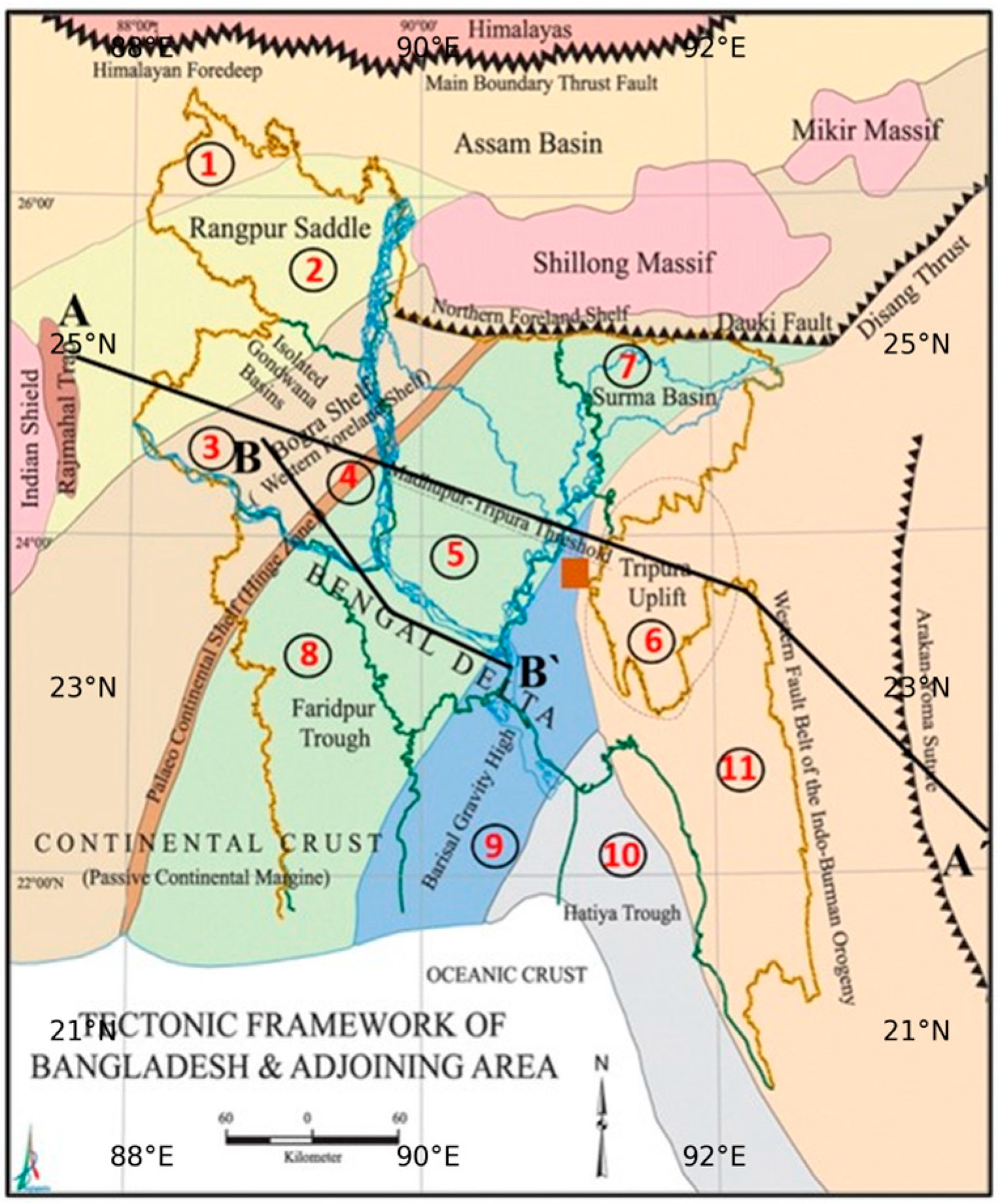
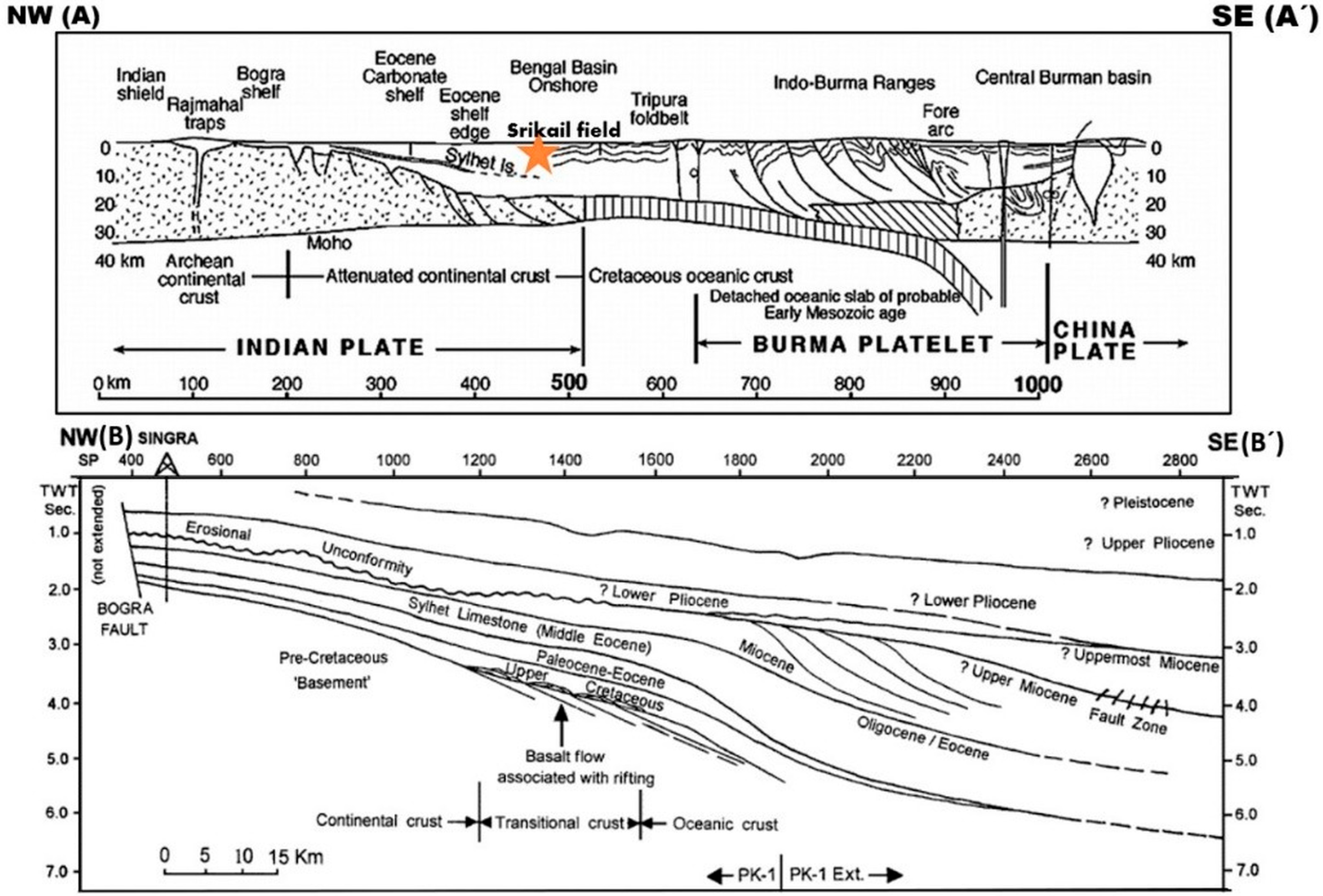
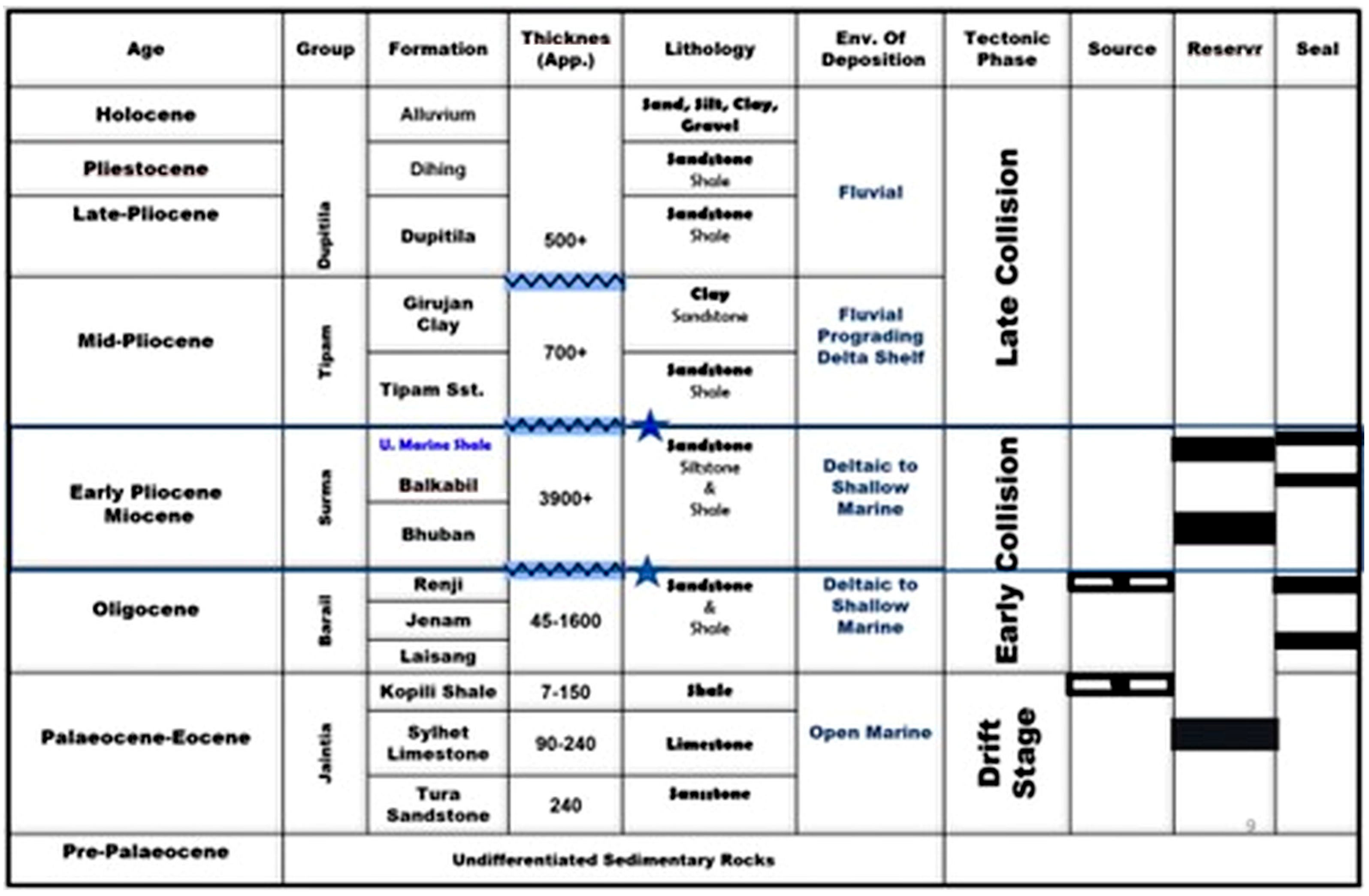


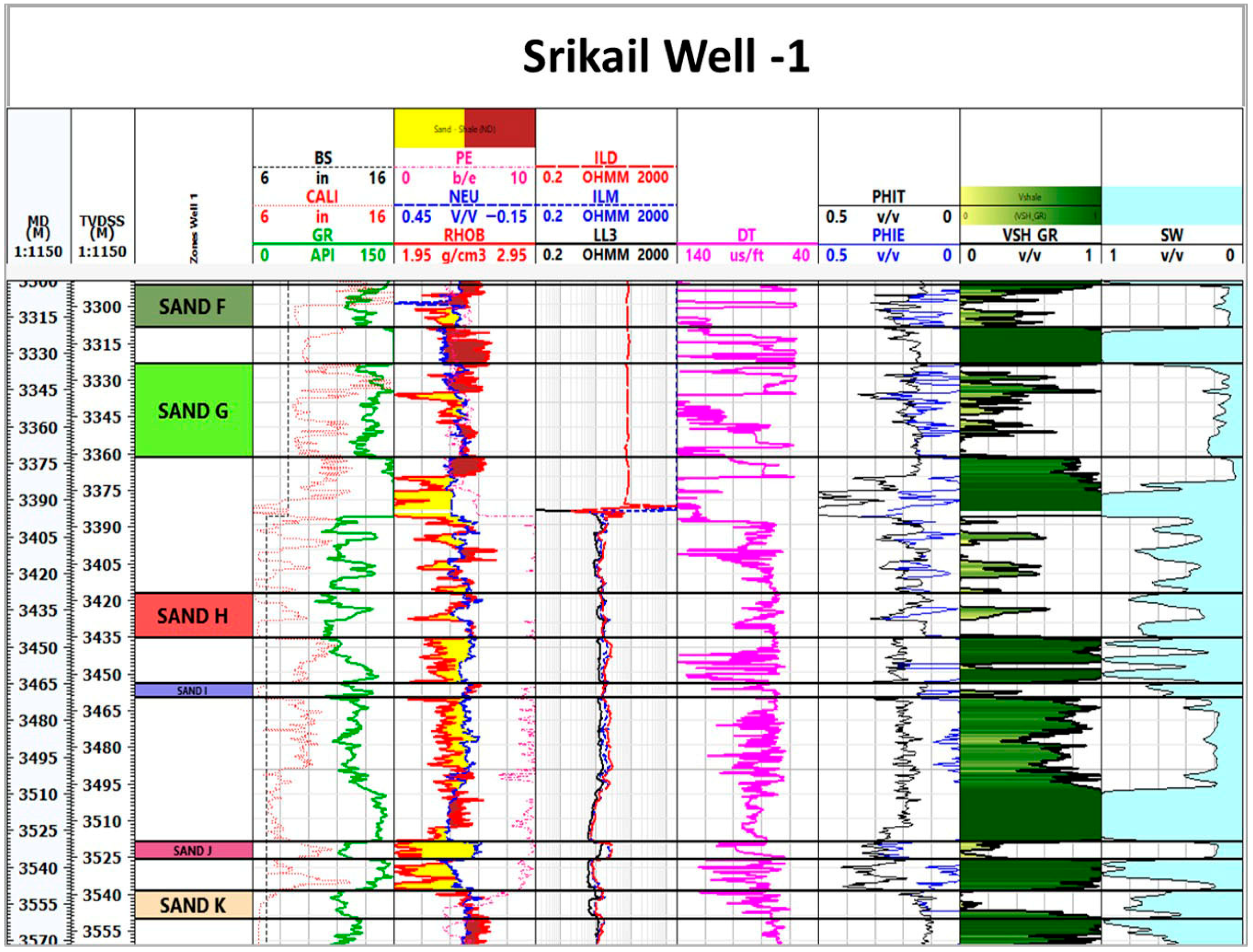


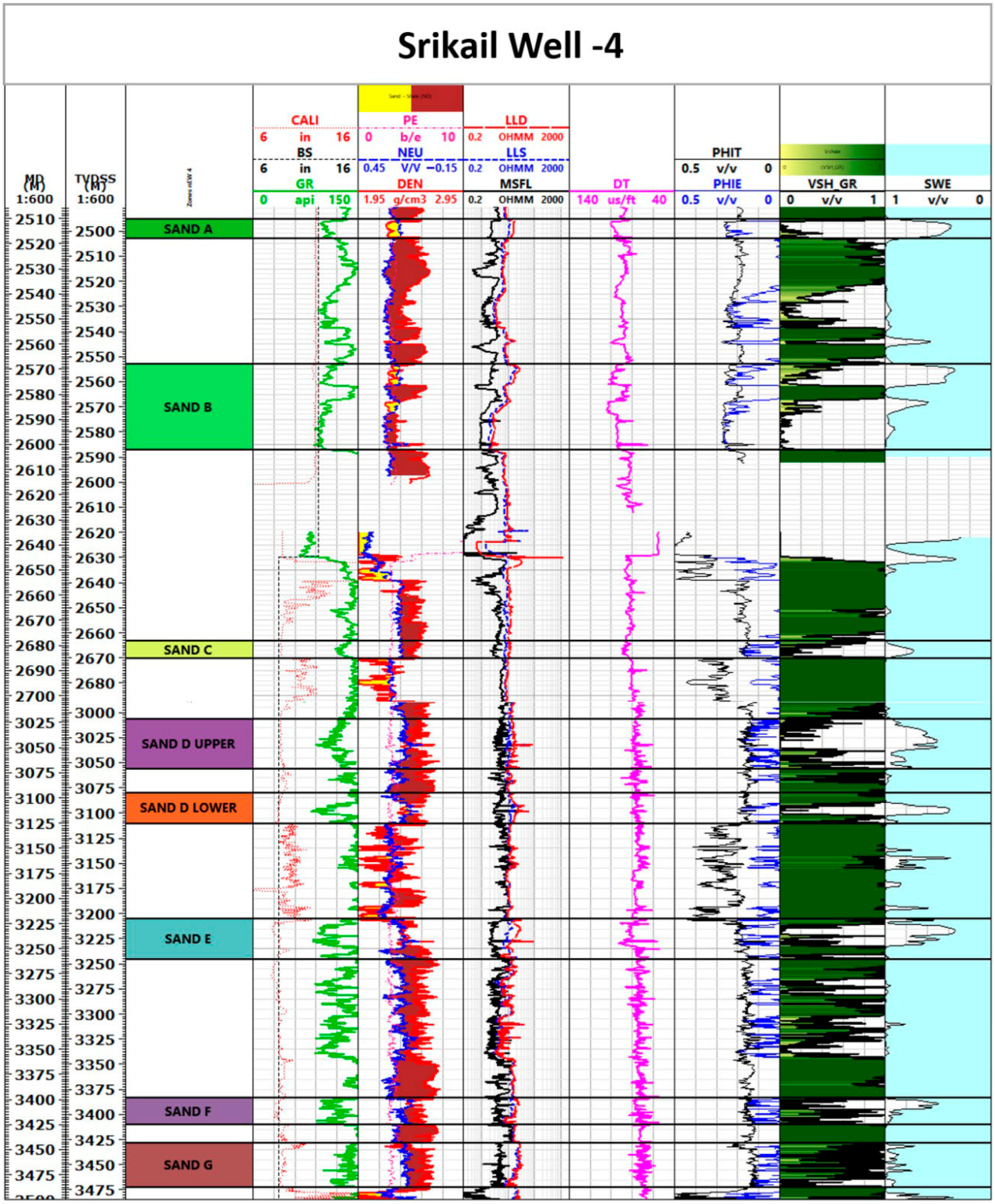
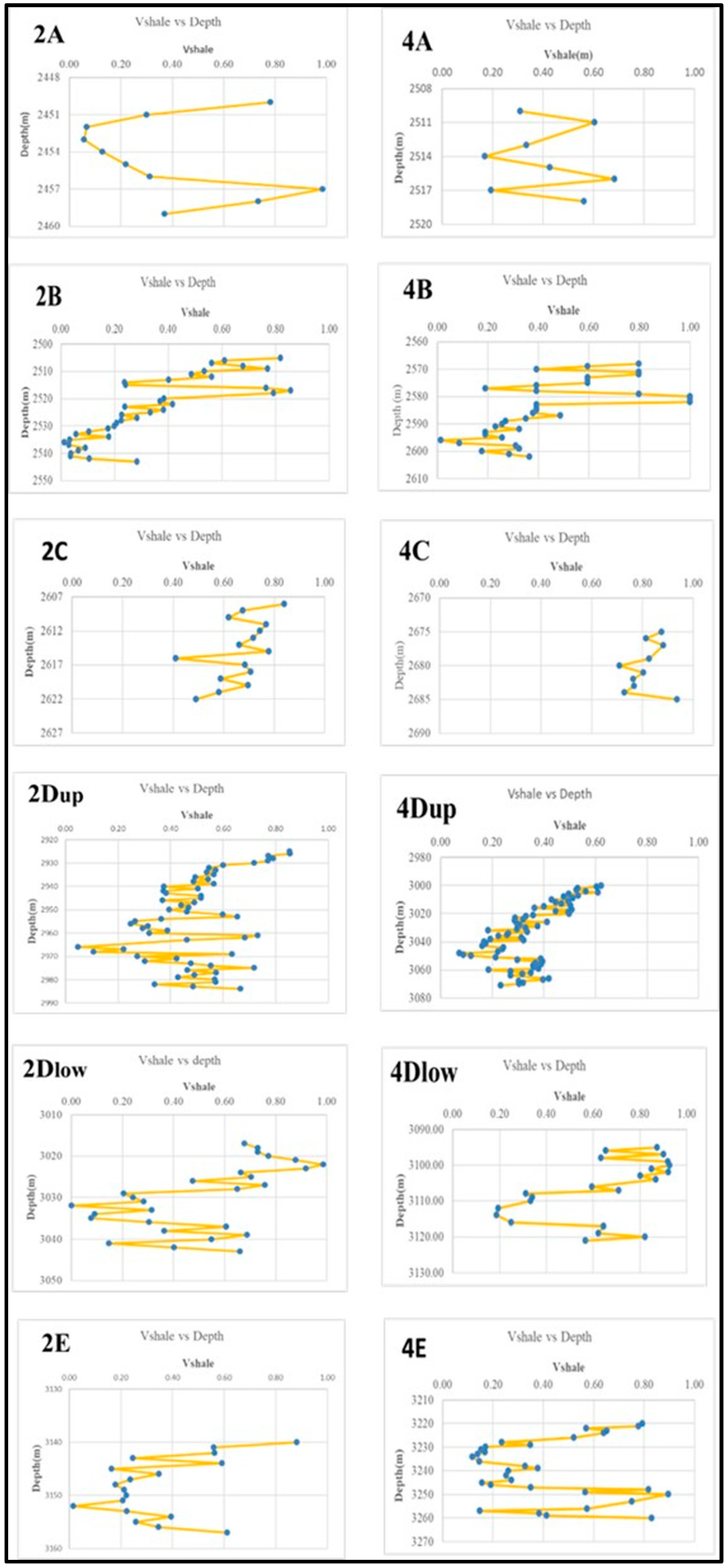
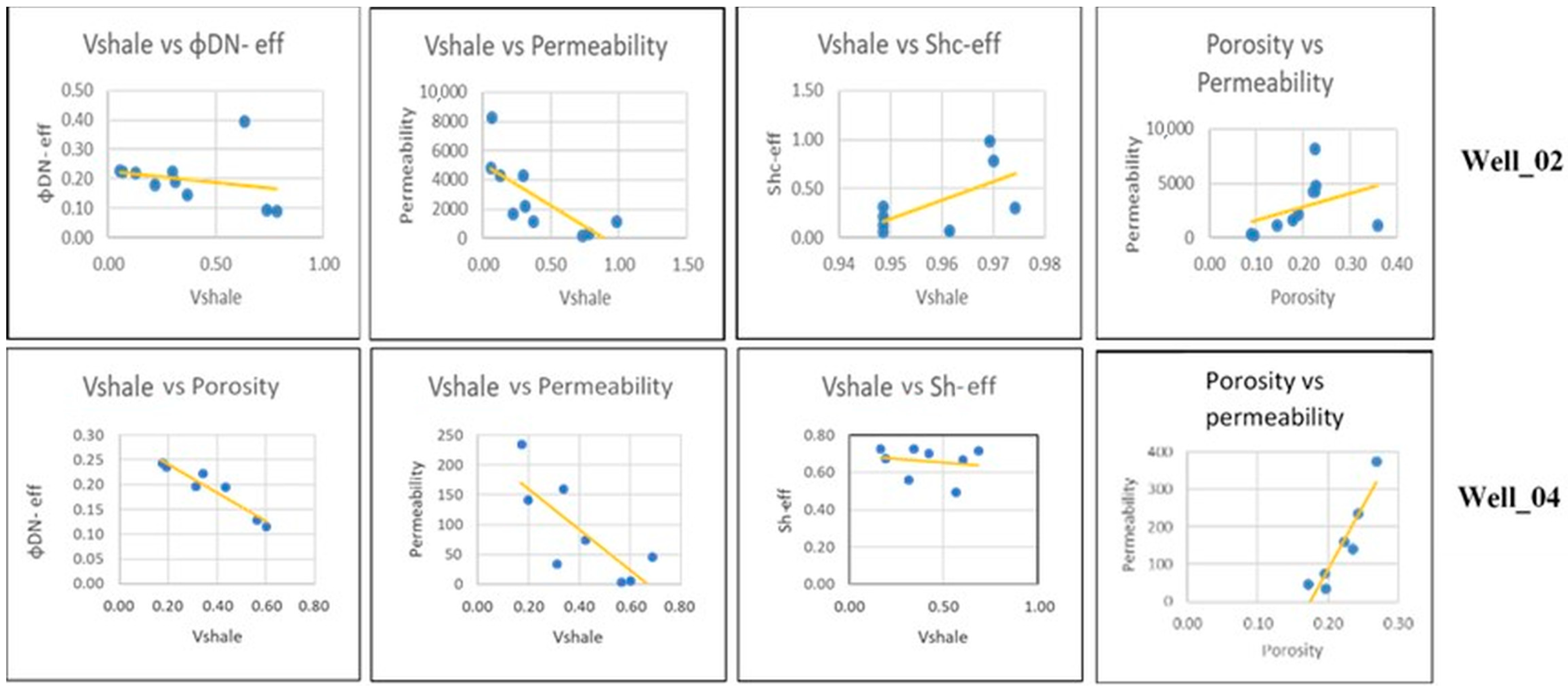

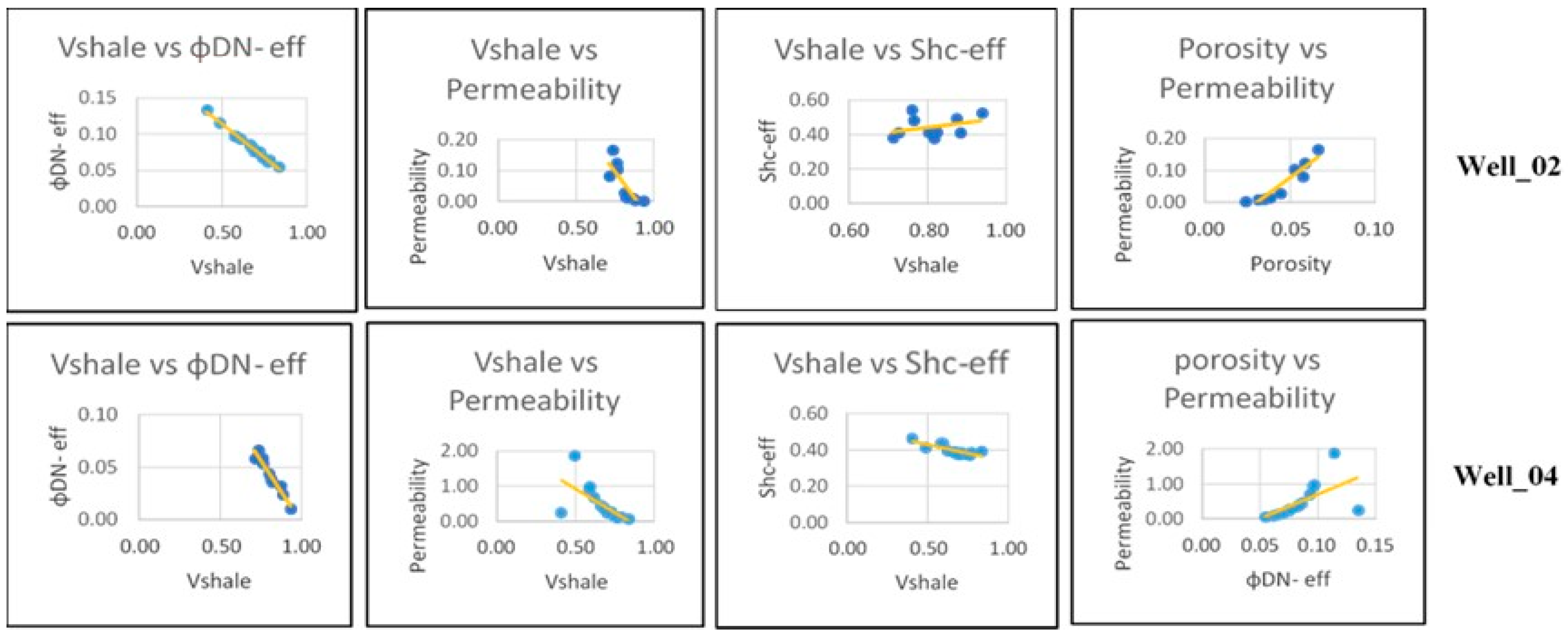
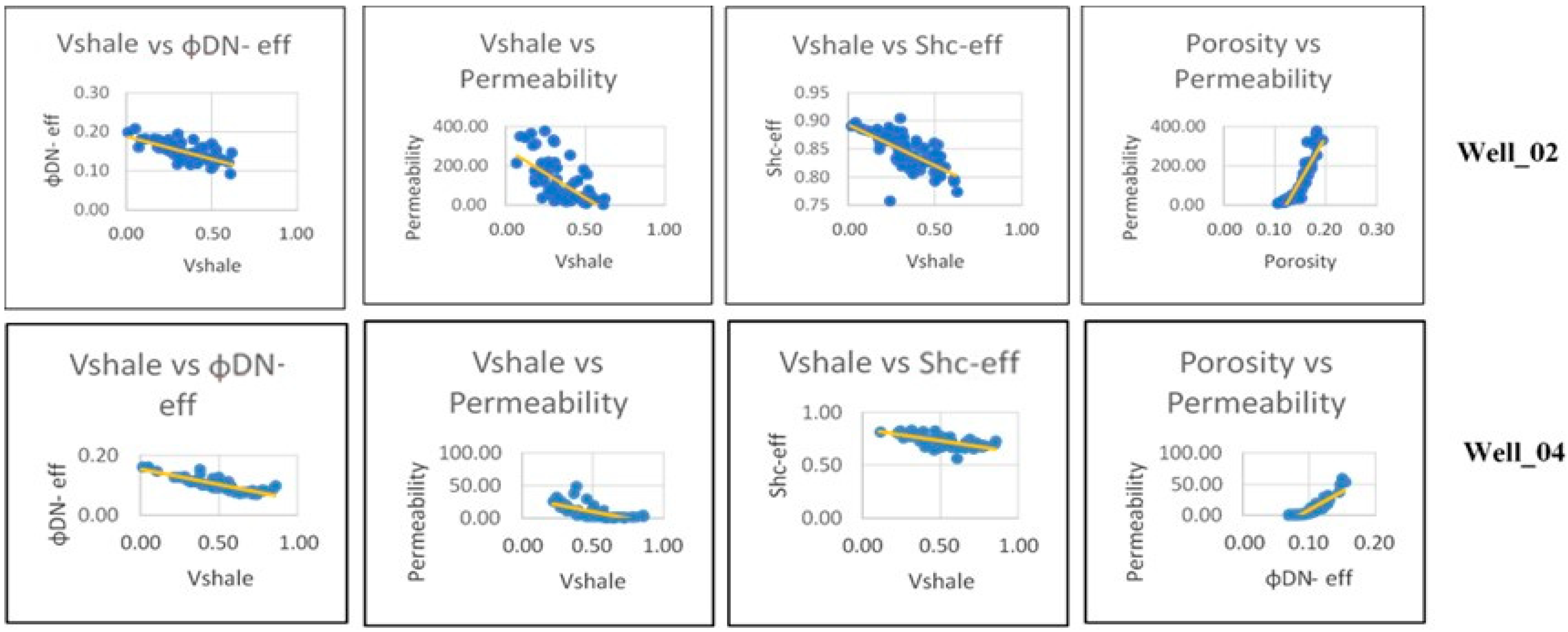
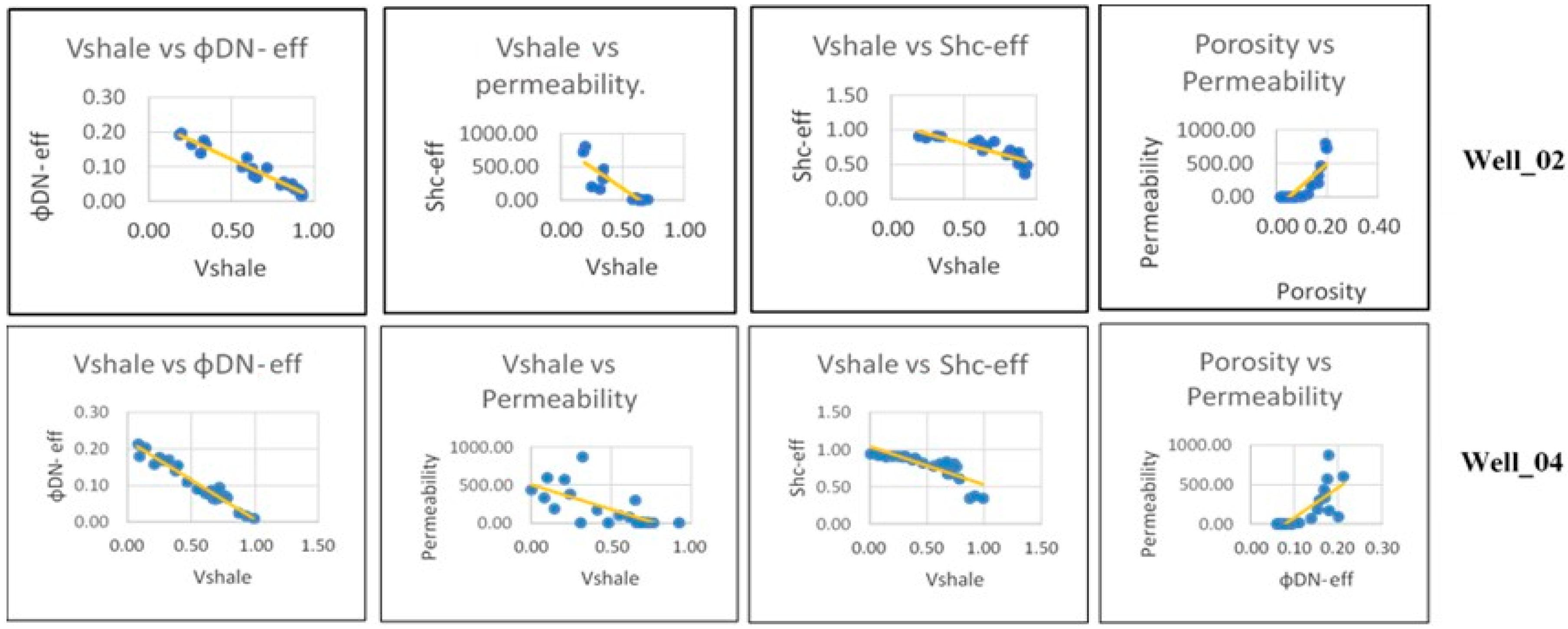


| Hole Section | Scale | Description |
|---|---|---|
| 12.25″ | 1:200/1:500/1:1000 MD | Composite Log |
| 12.25″ | 1:200/1:500/1:1000 MD | GR/SP/Resistivity |
| 12.25″ | 1:200/1:500/1:1000 MD | Density/Porosity/Cali/GR |
| 12.25″ | 1:200 MD | Composite Plot |
| 8.5″ | 1:200/1:500/1:1000 MD | Composite Log |
| 8.5″ | 1:200/1:500/1:1000 MD | GR/SP/Resistivity |
| 8.5″ | 1:200/1:500/1:1000 MD | Density/Porosity/Cali/GR |
| 8.5″ | 1:200 MD | Full Wave Sonic/GR |
| Well | Zone | Test Type | Perforation Interval (m) | Result |
|---|---|---|---|---|
| Well-1 | G | Conventional Testing | 3334–3341 m and 3343–3350 m | Maximum gas flow 1.2 MMSCFD. Permeability 0.0l mD. |
| H | DST-2 | 3410–3413 m, 3428–3430 m and 3439–3442 m | Highly calcareous. No visual porosity. Gas show 1.49% at 3408 m. Tight. Non-measurable flow. Permeability 0.0149 mD. | |
| J | DST-1 | 3530–3534 m | Highly calcareous. No visual porosity. Water and minor gas flow. | |
| Well-2 | D upper | DST-2 | 2963.55–2969 m | Commercial gas flow. |
| D lower | DST-1 | 3026.8–3029.8 m and 3030–3036.5 m | Commercial gas flow. | |
| Well-3 | D upper | DST-2 | 3097–3104 m | Commercial gas flow. |
| D lower | DST-1 | 3185–3190 m | Commercial gas flow. | |
| Well-4 | E | DST-1 | 3220–3231 m | Commercial gas flow. |
| Sand | Well_1 | Well_2 | Well_3 | Well_4 | ||||
|---|---|---|---|---|---|---|---|---|
| GRmin | GRmax | GRmin | GRmax | GRmin | GRmax | GRmin | GRmax | |
| Av. Vsh (%) | Av. Vsh (%) | Av. Vsh (%) | Av. Vsh (%) | |||||
| A | 73 | 134 | 77 | 142 | 80 | 135 | 96 | 126 |
| 36% | 42% | 48% | 37% | |||||
| B | 94 | 159 | 67 | 146 | 80 | 144 | 96 | 150 |
| 43% | 35% | 31% | 45% | |||||
| C | 97 | 133 | 68 | 146 | 70 | 134 | 65 | 149 |
| 56% | 60% | 46% | 83% | |||||
| Dupper | - | 80 | 150 | 80 | 150 | 99 | 186 | |
| 48% | 49% | 34% | ||||||
| Dlower | - | 73 | 148 | 77 | 154 | 90 | 161 | |
| 51% | 44% | 60% | ||||||
| E | - | 74 | 155 | 80 | 137 | 90 | 158 | |
| 35% | 43% | 45% | ||||||
| F | - | - | - | 100 | 171 | |||
| 39% | ||||||||
| G | 90 | 159 | - | - | 100 | 171 | ||
| 52% | 50% | |||||||
| H | 74 | 113 | - | - | ||||
| 41% | ||||||||
| I | 80 | 124 | - | - | ||||
| 57% | ||||||||
| J | 90 | 134 | - | - | ||||
| 42% | ||||||||
| K | 85 | 134 | - | - | ||||
| 37% | ||||||||
| Sand | Well_1 | Well_2 | Well_3 | Well_4 | ||||
|---|---|---|---|---|---|---|---|---|
| ϕD_eff | ϕN_eff | ϕD_eff | ϕN_eff | ϕD_eff | ϕN_eff | ϕD_eff | ϕN_eff | |
| ϕDN-eff (%) | ϕDN-eff (%) | ϕDN-eff (%) | ϕDN-eff (%) | |||||
| A | 15 | 14 | 19 | 20 | 11 | 17 | 17 | 21 |
| 15% | 21% | 15% | 20% | |||||
| B | 13 | 17 | 15 | 21 | 12 | 24 | 14 | 19 |
| 13% | 18% | 19% | 17% | |||||
| C | 07 | 08 | 07 | 09 | 9 | 10 | 02 | 05 |
| 08% | 8% | 7% | 04% | |||||
| Dupper | 12 | 11 | 12 | 14 | 12 | 20 | ||
| 12% | 14% | 15% | ||||||
| Dlower | 10 | 14 | 11 | 15 | 12 | 11 | ||
| 12% | 14% | 12% | ||||||
| E | 11 | 18 | 12 | 14 | 13 | 17 | ||
| 15% | 15% | 16% | ||||||
| F | 08 | 19 | ||||||
| 14% | ||||||||
| G | 09 | 10 | 04 | 07 | ||||
| 10% | 7% | |||||||
| H | 11 | 09 | ||||||
| 11% | ||||||||
| I | 11 | 05 | ||||||
| 10% | ||||||||
| J | 14 | 09 | ||||||
| 11% | ||||||||
| K | 13 | 11 | ||||||
| 11% | ||||||||
| Sand | Well_1 | Well_2 | Well_3 | Well_4 | ||||
|---|---|---|---|---|---|---|---|---|
| Sw-eff (%) | Shc-eff (%) | Sw-eff (%) | Shc-eff (%) | Sw-eff (%) | Shc-eff (%) | Sw-eff (%) | Shc-eff (%) | |
| A | 35 | 65 | 4 | 96 | 40 | 60 | 33 | 67 |
| B | 40 | 60 | 25 | 75 | 31 | 69 | 23 | 77 |
| C | 42 | 58 | 45 | 55 | 40 | 60 | 45 | 55 |
| Dupper | - | 26 | 74 | 20 | 80 | 14 | 86 | |
| Dlower | - | 22 | 78 | 17 | 83 | 26 | 74 | |
| E | - | 40 | 60 | 22 | 78 | 34 | 66 | |
| F | - | - | - | 40 | 60 | |||
| G | 46 | 54 | - | - | 46 | 54 | ||
| H | 17 | 83 | - | - | - | |||
| I | 16 | 84 | - | - | - | |||
| J | 19 | 81 | - | - | - | |||
| K | 22 | 78 | - | - | - | |||
| Sand | Well_1 | Well_2 | Well_3 | Well_4 |
|---|---|---|---|---|
| K (mD) | K (mD) | K (mD) | K (mD) | |
| A | 83 | 206 | 117 | 120 |
| B | 46 | 158 | 161 | 227 |
| C | 0.08 | 0.11 | 0.13 | 0.05 |
| Dupper | - | 111 | 102 | 129 |
| Dlower | - | 355 | 117 | 291 |
| E | - | 40 | 66 | 58 |
| F | 14 | - | - | 18 |
| G | 1.01 | - | - | 2.6 |
| H | 61 | - | - | - |
| I | 67 | - | - | - |
| J | 64 | - | - | - |
| K | 22 | - | - | - |
| Sands | (BVW) |
|---|---|
| A | 0.040–0.060 |
| B | 0.030–0.050 |
| C | 0.037–0.040 |
| Dupper | 0.020–0.027 |
| Dlower | 0.020–0.024 |
| E | 0.035–0.080 |
Disclaimer/Publisher’s Note: The statements, opinions and data contained in all publications are solely those of the individual author(s) and contributor(s) and not of MDPI and/or the editor(s). MDPI and/or the editor(s) disclaim responsibility for any injury to people or property resulting from any ideas, methods, instructions or products referred to in the content. |
© 2025 by the authors. Licensee MDPI, Basel, Switzerland. This article is an open access article distributed under the terms and conditions of the Creative Commons Attribution (CC BY) license (https://creativecommons.org/licenses/by/4.0/).
Share and Cite
Akhter, S.; Pimentel, N. Integrated Petrophysical Analysis and Reservoir Characterization of Shaly Sands in the Srikail Gas Field, East Central Bengal Basin, Bangladesh. Eng 2025, 6, 234. https://doi.org/10.3390/eng6090234
Akhter S, Pimentel N. Integrated Petrophysical Analysis and Reservoir Characterization of Shaly Sands in the Srikail Gas Field, East Central Bengal Basin, Bangladesh. Eng. 2025; 6(9):234. https://doi.org/10.3390/eng6090234
Chicago/Turabian StyleAkhter, Shireen, and Nuno Pimentel. 2025. "Integrated Petrophysical Analysis and Reservoir Characterization of Shaly Sands in the Srikail Gas Field, East Central Bengal Basin, Bangladesh" Eng 6, no. 9: 234. https://doi.org/10.3390/eng6090234
APA StyleAkhter, S., & Pimentel, N. (2025). Integrated Petrophysical Analysis and Reservoir Characterization of Shaly Sands in the Srikail Gas Field, East Central Bengal Basin, Bangladesh. Eng, 6(9), 234. https://doi.org/10.3390/eng6090234













